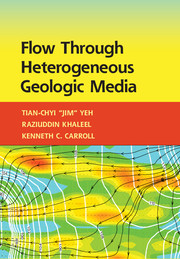Book contents
- Frontmatter
- Contents
- Preface and Acknowledgments
- 1 Fluid Statics and Dynamics
- 2 Darcy's Law for Saturated Porous Media
- 3 Darcy's Law for Unsaturated Porous Media
- 4 Stochastic Conceptualization of Heterogeneity
- 5 Governing Flow Equations for Heterogeneous Media Conceptual Models
- 6 Equivalent Homogeneous Media Conceptual Models
- 7 Flow toward a Well Due to Pumping (Part 1)
- 8 Flow toward a Well Due to Pumping (Part 2)
- 9 Stochastic Approaches
- References
- Index
1 - Fluid Statics and Dynamics
Published online by Cambridge University Press: 05 July 2015
- Frontmatter
- Contents
- Preface and Acknowledgments
- 1 Fluid Statics and Dynamics
- 2 Darcy's Law for Saturated Porous Media
- 3 Darcy's Law for Unsaturated Porous Media
- 4 Stochastic Conceptualization of Heterogeneity
- 5 Governing Flow Equations for Heterogeneous Media Conceptual Models
- 6 Equivalent Homogeneous Media Conceptual Models
- 7 Flow toward a Well Due to Pumping (Part 1)
- 8 Flow toward a Well Due to Pumping (Part 2)
- 9 Stochastic Approaches
- References
- Index
Summary
Introduction
Our experience suggests that most students from geosciences, natural sciences, and other backgrounds are not required to take a fluid mechanics class, and most engineering students who took a fluid mechanics class earlier may still need to reinforce their physical understanding of the fluid mechanics concepts. Thereby, this chapter is intended to provide readers with some basics of fluid mechanics (particularly, in terms of physics) that are essential to understand and appreciate flow through geologic media.
Fluid Mechanics is the study of the forces on fluids. These fluids can be either a gas or a liquid. Fluid Mechanics includes both fluid statics (the study of fluids at rest) and fluid dynamics (the study of fluids in motion). Notice that the fluid mechanics serves as the fundamental principles in a number of disciplines in science and engineering. For instance, atmospheric science is built upon fluid mechanics, as is cardiology – the study of the blood flow through our veins and arteries. The study of the infiltration of water and its subsequent movement in unsaturated subsurface media (vadose zone hydrology) also relies on fluid mechanics, as do studies of the movement of groundwater in geologic media (groundwater hydrology). Other disciplines include surface hydrology (the study of movement of water on land surfaces, in canals and rivers, and in oceans, lakes, estuaries, etc.), and petroleum engineering that studies the movement of oil and gas in geologic reservoirs. Examples also include hydraulics which studies fluid motions in pipes or man-made conduits (conduit flow systems).
This chapter first introduces readers to the basic continuum assumption (i.e., volume averaging concept). Then, definitions of fluid properties and their units follow. Forces of static fluids and the relationship between forces and energies are discussed subsequently. The chapter then examines fluid dynamics, in which the fixed and moving coordinate systems are introduced, the time derivatives associated with these two coordinate systems are brought forth, and fluid acceleration is investigated. Using force balance and acceleration concepts, we derive the Bernoulli equation for flow through pipe; we elucidate its physical meaning in term of conservation of energy, which leads to the concept of total, pressure, velocity, and potential heads. Head loss due to viscous forces ignored by the Bernoulli equation then explains the limitation of the equation for flow through real-world systems.
- Type
- Chapter
- Information
- Flow through Heterogeneous Geologic Media , pp. 1 - 31Publisher: Cambridge University PressPrint publication year: 2015



